20 Best Sight Word Books for Autistic Students
This resource was created as a supplement for the ARIS® Academic Readiness Intervention System Language Builder: A complete early autism curriculum, Lesson #158, Reading Sight Words in Simple Sentences, and Lesson #159, Reading Sight Words in Simple Books. Download a free copy of lesson 158 and lesson 159 and learn more about the ARIS curriculum.
Language development can be challenging for autistic students and can impact reading comprehension. Using sight word instruction is a great tool for helping autistic children succeed!
So much of a student’s understanding of language development and positive social skill development can come from the experiences students have while reading. Language development and social communication are areas that can be more challenging skill sets to develop for autistic students, thereby affecting their reading comprehension and fluency abilities (Teaching Exceptional Thinkers, n.d.). Sight word instruction provides a tool that can support autistic students as they learn to read by recognizing whole words quickly, rather than sounding them out.
The benefits of sight word instruction are numerous. Researchers like Janet Spector highlighted these benefits in her research on sight word instruction for autistic students (Spector, 2010). She noted that sight word instruction, when used as an introduction to reading, can provide a sense of accomplishment and motivation around learning to read, which may be more difficult to achieve in a phonics-based approach (Spector, 2010). Autistic students sometimes have difficulty with concepts that tend to be more abstract and auditory-focused (Spector, 2010). Additionally, sight word instruction is a good foundation for more abstract alphabetic concepts, and can ensure accessibility for students who may otherwise be unable to perform functional tasks, like reading items on a menu for example.
Recognizing the importance and benefits of sight word instruction, we have curated a list of twenty of the best sight word books for instruction for autistic students. Check out the books and their accompanying links below!
Spooky Pookie by Sandra Boynton
 For all of the children who are Halloween lovers, Spooky Pookie is a fun book about what little Pookie will be for Halloween. Sandra Boynton is a bestselling author, and this book is full of different sight words and other fun adjectives that will not only enhance your child’s vocabulary but will also allow them to get great practice with a variety of sight words.
For all of the children who are Halloween lovers, Spooky Pookie is a fun book about what little Pookie will be for Halloween. Sandra Boynton is a bestselling author, and this book is full of different sight words and other fun adjectives that will not only enhance your child’s vocabulary but will also allow them to get great practice with a variety of sight words.
Little Blue Truck by Alice Schertle; illustrated by Jill McElmurry
 Little Blue Truck written by Alice Schertle and illustrated by Jill McElmurry offers a fun reading experience for autistic children. In this book, farm animal friends work together to help out the little pickup truck that gets stuck in the mud. This book contains many different sight words, onomatopoeia, and great lessons on friendship and helping others that will be both educational and exciting for your autistic child, especially if they love trucks and animals!
Little Blue Truck written by Alice Schertle and illustrated by Jill McElmurry offers a fun reading experience for autistic children. In this book, farm animal friends work together to help out the little pickup truck that gets stuck in the mud. This book contains many different sight words, onomatopoeia, and great lessons on friendship and helping others that will be both educational and exciting for your autistic child, especially if they love trucks and animals!
Gossie by Olivier Dunrea
 In this charming picture book, author Olivier Dunrea tells the story of Gossie, a yellow duckling who loves wearing red boots. One day, Gossie loses her red boots and looks everywhere for them. As children read this book and seek to find Gossie’s red boots, they will be exposed to a variety of sight words and simple sentences, while also learning key social skills like how to approach confusion calmly and how to be forgiving of others.
In this charming picture book, author Olivier Dunrea tells the story of Gossie, a yellow duckling who loves wearing red boots. One day, Gossie loses her red boots and looks everywhere for them. As children read this book and seek to find Gossie’s red boots, they will be exposed to a variety of sight words and simple sentences, while also learning key social skills like how to approach confusion calmly and how to be forgiving of others.
A Hat for Minerva Louise by Janet Morgan Stoeke
 Minerva Louise is a character that may be well known to many. In this book, young readers go on an adventure with Minerva as she seeks to find something warm in snowy weather. Light and funny, this book is filled with plenty of sight words that will be great practice and exposure for your autistic child.
Minerva Louise is a character that may be well known to many. In this book, young readers go on an adventure with Minerva as she seeks to find something warm in snowy weather. Light and funny, this book is filled with plenty of sight words that will be great practice and exposure for your autistic child.
Bear Gets Dressed by Harriet Ziefert
 In this book, children practice guessing what Bear will wear when he goes outside in different types of weather. This book exposes young readers to different types of clothing that are appropriate for different types of weather. It also follows a simple, consistent pattern! Bear Gets Dressed contains a multitude of sight words and simple sentences that make reading it enjoyable and effective.
In this book, children practice guessing what Bear will wear when he goes outside in different types of weather. This book exposes young readers to different types of clothing that are appropriate for different types of weather. It also follows a simple, consistent pattern! Bear Gets Dressed contains a multitude of sight words and simple sentences that make reading it enjoyable and effective.
Where is the Green Sheep? by Mem Fox; illustrated by Judy Horacek
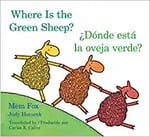 Not only is this book great for young readers as they learn colors and opposites, but it is also a wonderful book for practicing different sight words! Additionally, the version of this book linked here is the English-Spanish edition, making it accessible to English Language Learners or bilingual children.
Not only is this book great for young readers as they learn colors and opposites, but it is also a wonderful book for practicing different sight words! Additionally, the version of this book linked here is the English-Spanish edition, making it accessible to English Language Learners or bilingual children.
That’s Not My Owl by Usborne Touchy-Feely Books
 That’s Not My Owl is sure to be a sensory activator for many autistic students. If your child loves animals, this will be an exciting read. It has a lot of different sight words and great adjectives that are reinforced by various touch-and-feel points throughout the book.
That’s Not My Owl is sure to be a sensory activator for many autistic students. If your child loves animals, this will be an exciting read. It has a lot of different sight words and great adjectives that are reinforced by various touch-and-feel points throughout the book.
Outside, from Hubbard’s Cupboard
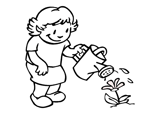 Hubbard’s Cupboard is a great website that provides a ton of resources for young children’s academic development. One of my favorite resources from this site is their free printable sight word booklets, like this one, Outside, and the next few below! Outside is a booklet that introduces the sight words, “I”, “see”, and “a.” It contains very simple sentences and very simple pictures, which your child can color.
Hubbard’s Cupboard is a great website that provides a ton of resources for young children’s academic development. One of my favorite resources from this site is their free printable sight word booklets, like this one, Outside, and the next few below! Outside is a booklet that introduces the sight words, “I”, “see”, and “a.” It contains very simple sentences and very simple pictures, which your child can color.
At School, from Hubbard’s Cupboard
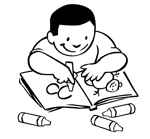 Another great booklet from Hubbard’s Cupboard, At School, introduces young readers to the sight words, “we” and “will.” While reading, your child may be able to see pictures that relate to the things they are likely doing at home or school: playing with blocks, coloring, counting, writing, and reading.
Another great booklet from Hubbard’s Cupboard, At School, introduces young readers to the sight words, “we” and “will.” While reading, your child may be able to see pictures that relate to the things they are likely doing at home or school: playing with blocks, coloring, counting, writing, and reading.
The Fall Basket, from Hubbard’s Cupboard
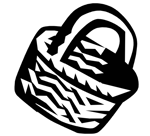 This seasonal booklet introduces students to the sight word “in” while exposing them to many common things that someone may see during the fall season. It incorporates various nouns like “acorns,” “corn,” and even “scarecrow.”
This seasonal booklet introduces students to the sight word “in” while exposing them to many common things that someone may see during the fall season. It incorporates various nouns like “acorns,” “corn,” and even “scarecrow.”
Set the Table, from Hubbard’s Cupboard
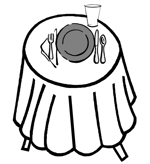 The main sight word that you will see throughout this booklet is the word “there.” One of the reasons why we love this particular booklet from Hubbard’s Cupboard is because it exposes students to the many different items that are involved in place setting and dinner etiquette. The final picture in this booklet shows a completed table that is set appropriately.
The main sight word that you will see throughout this booklet is the word “there.” One of the reasons why we love this particular booklet from Hubbard’s Cupboard is because it exposes students to the many different items that are involved in place setting and dinner etiquette. The final picture in this booklet shows a completed table that is set appropriately.
At the Castle, from Hubbard’s Cupboard
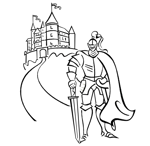 If you have a child who enjoys all things fantasy, then this printable booklet may be the one for you! This booklet introduces the sight words, “who,” “what,” and “that” while giving well-drawn pictures that represent the people and things we may find at a castle. Like the other Hubbard’s Cupboard books identified on this list, this booklet uses simple, easy-to-read sentences that are perfect for young readers learning and practicing their sight words.
If you have a child who enjoys all things fantasy, then this printable booklet may be the one for you! This booklet introduces the sight words, “who,” “what,” and “that” while giving well-drawn pictures that represent the people and things we may find at a castle. Like the other Hubbard’s Cupboard books identified on this list, this booklet uses simple, easy-to-read sentences that are perfect for young readers learning and practicing their sight words.
Summer, from Hubbard’s Cupboard
 What better way to close out the summer season than a summer-themed book? Summer introduces students to the sight word “would” while reviewing older, easier sight words like “like,” “to,” and “do.” In this printable booklet, students are not only exposed to these sight words, but they are also exposed to pictures of many different summer activities like eating ice cream, going on picnics, and making sandcastles. It also offers space at the bottom for students to share their thoughts on what they would like to do during the summer.
What better way to close out the summer season than a summer-themed book? Summer introduces students to the sight word “would” while reviewing older, easier sight words like “like,” “to,” and “do.” In this printable booklet, students are not only exposed to these sight words, but they are also exposed to pictures of many different summer activities like eating ice cream, going on picnics, and making sandcastles. It also offers space at the bottom for students to share their thoughts on what they would like to do during the summer.
Brown Bear, Brown Bear, What Do You See? by Bill Martin Jr. and Eric Carle
 Brown Bear, Brown Bear, What Do You See is a true classic. This beautifully illustrated book will introduce your child to various colors while also providing them an opportunity to practice different sight words. This book has a simple pattern and uses repetitive phrases which allows students to anchor themselves in the text while reading.
Brown Bear, Brown Bear, What Do You See is a true classic. This beautifully illustrated book will introduce your child to various colors while also providing them an opportunity to practice different sight words. This book has a simple pattern and uses repetitive phrases which allows students to anchor themselves in the text while reading.
Where’s Spot? by Eric Hill
 If your child loves dogs, then Where’s Spot will likely be an exciting read. In this book, Eric Hill uses repetitive phrases and simple sentences full of both easy and more challenging sight words like “can,” “inside,” and “behind.”
If your child loves dogs, then Where’s Spot will likely be an exciting read. In this book, Eric Hill uses repetitive phrases and simple sentences full of both easy and more challenging sight words like “can,” “inside,” and “behind.”
Nonfiction Sight Word Readers by Liza Charlesworth
 These sight word readers are so helpful for young children who are working on their sight words. They come in leveled packs with about 25 books per pack. All of the books focus on real-world topics that are sure to engage your child. While the link above is to the initial set, you can find more sets under the related items section!
These sight word readers are so helpful for young children who are working on their sight words. They come in leveled packs with about 25 books per pack. All of the books focus on real-world topics that are sure to engage your child. While the link above is to the initial set, you can find more sets under the related items section!
Bob Books Sight Words by Lynn Maslen Kertell; illustrated by Sue Hendra
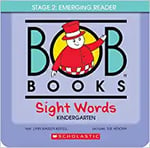 Another classic set of sight word books, these books typically come in a box set and are solely focused on helping students become more fluent readers. Through simple stories, young readers can focus on three sight words at a time in each book. The books utilize a lot of repetition and are a great resource for autistic children as they master their sight words. Check out the link to order the Kindergarten set and sets for multiple levels.
Another classic set of sight word books, these books typically come in a box set and are solely focused on helping students become more fluent readers. Through simple stories, young readers can focus on three sight words at a time in each book. The books utilize a lot of repetition and are a great resource for autistic children as they master their sight words. Check out the link to order the Kindergarten set and sets for multiple levels.
I See a Cat by Paul Meisel
My Dragon and I by Maria Fleming; illustrated by Mike Gordon
 The Sight Word Tales are a series of books that are meant to introduce and reinforce sight words through engaging stories. One of those books, My Dragon and I, is a great, imaginative book that introduces the sight words “my,” “and,” “I,” and “like.” At the link above, you can purchase My Dragon and I and also see other Sight Word Tales books in the series!
The Sight Word Tales are a series of books that are meant to introduce and reinforce sight words through engaging stories. One of those books, My Dragon and I, is a great, imaginative book that introduces the sight words “my,” “and,” “I,” and “like.” At the link above, you can purchase My Dragon and I and also see other Sight Word Tales books in the series!
What a Wonderful World by Bob Thiele and George David Weiss; illustrated by Tim Hopgood
 Sound familiar? This brightly illustrated book is based on the hit song by Louis Armstrong, “What a Wonderful World.” Young readers practicing their sight words will love this book and all of its vibrant colors and simple sentences. To make reading even more engaging, this book can be read and sung like the song! Autistic children will enjoy singing along and learning sight words like “so,” “in,” “the,” “how,” and more.
Sound familiar? This brightly illustrated book is based on the hit song by Louis Armstrong, “What a Wonderful World.” Young readers practicing their sight words will love this book and all of its vibrant colors and simple sentences. To make reading even more engaging, this book can be read and sung like the song! Autistic children will enjoy singing along and learning sight words like “so,” “in,” “the,” “how,” and more.
References
Spector, Janet. (2010). Sight Word Instruction for Students with Autism: An Evaluation of the
Evidence Base. Journal of autism and developmental disorders. 41. 1411-22.
10.1007/s10803-010-1165-x.
Teaching Exceptional Thinkers. (n.d.). Teaching Kids with Autism How to Read. https://teachingexceptionalthinkers.com/2019/02/13/teaching-kids-with-autism-how-to-read/
This resource was created as a supplement for the ARIS Language Builder: Complete early autism curriculum, Lesson #158, Reading Sight Words in Simple Sentences, and Lesson #159, Reading Sight Words in Simple Books. Download a free copy of lesson 158 and lesson 159 and learn more about the ARIS curriculum.

Madeline Burroughs
Madeline Burroughs is a Specially Designed Instructional Coach at two high schools in Fulton County Schools in Atlanta, GA. In this role, she works to coach special education teachers in providing systematic, specially designed instruction that effectively targets students’ strengths and needs. Madeline received her Master’s degree in Education Policy and Management from Harvard Graduate School of Education in May 2019, and hopes to continue to serve as an advocate for all students with disabilities throughout her career.





